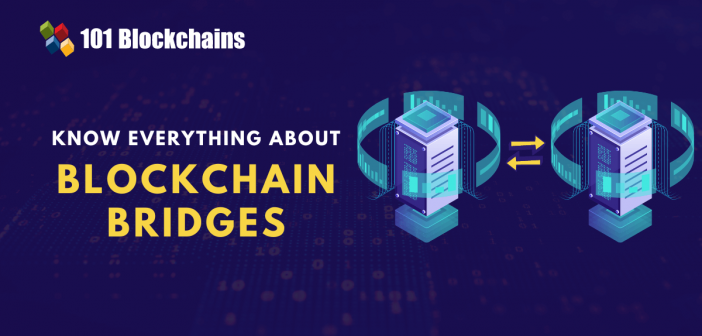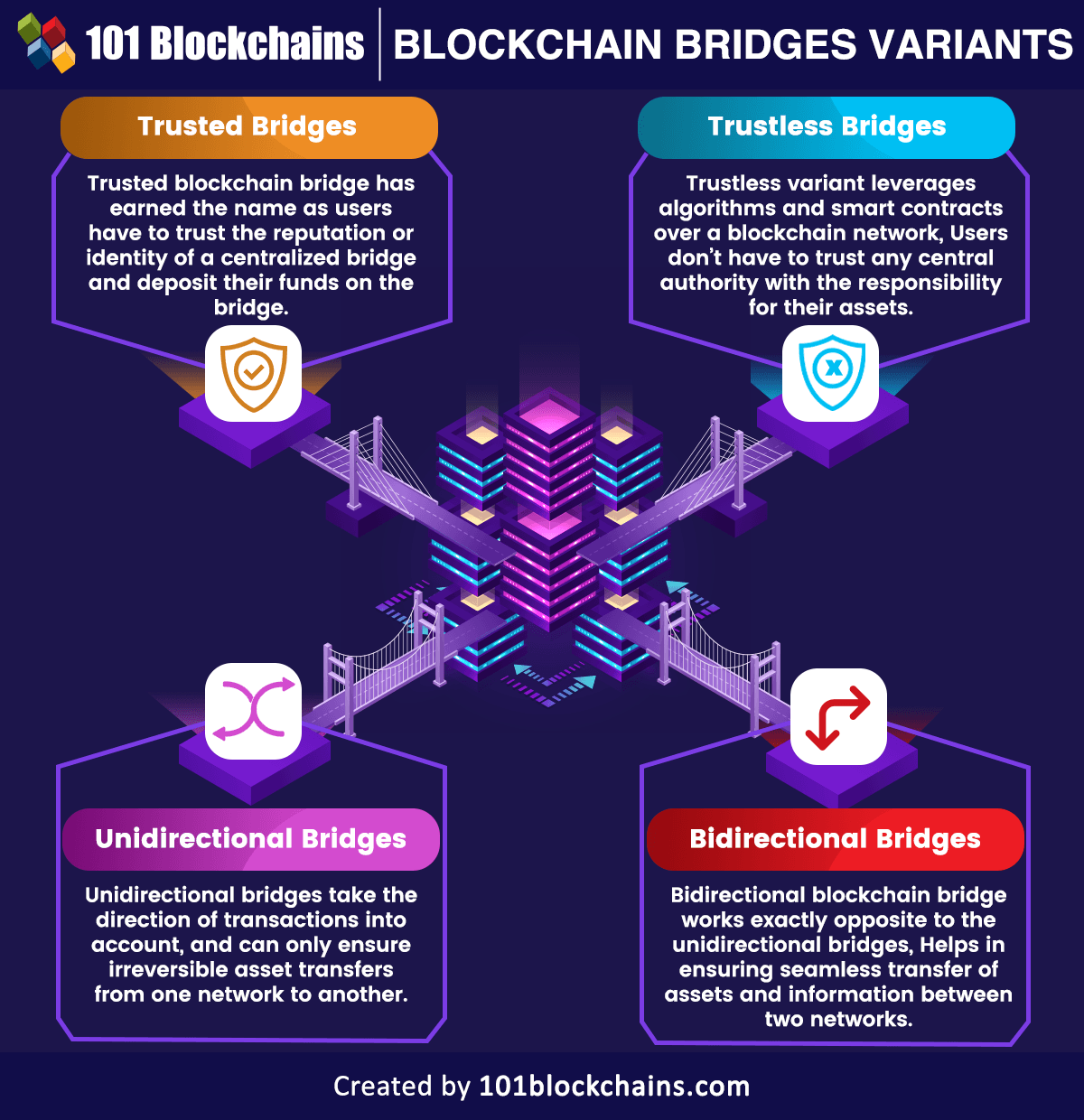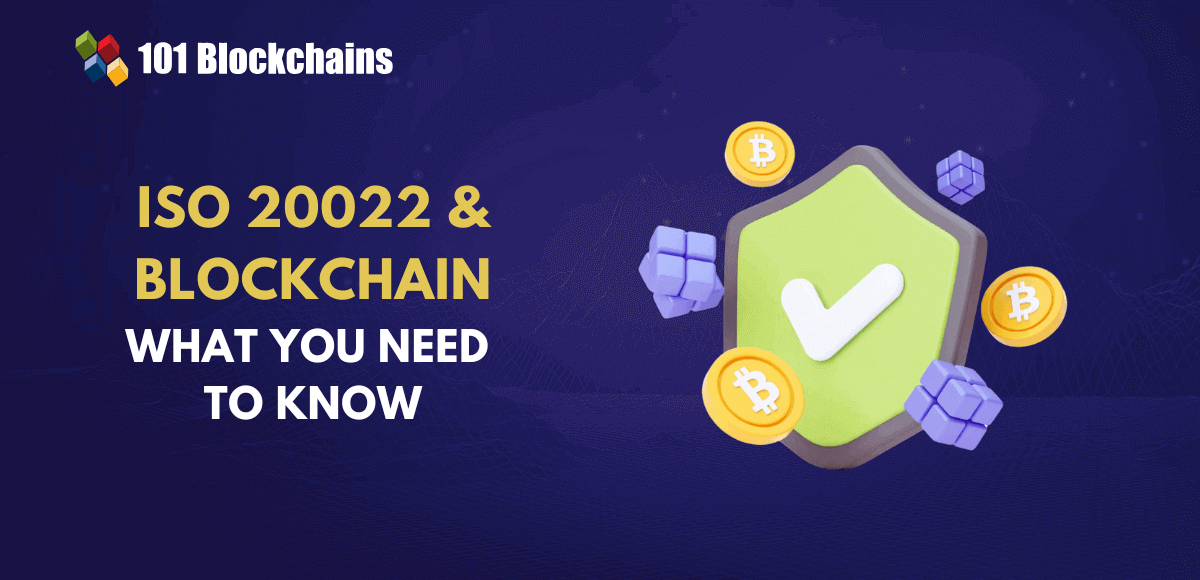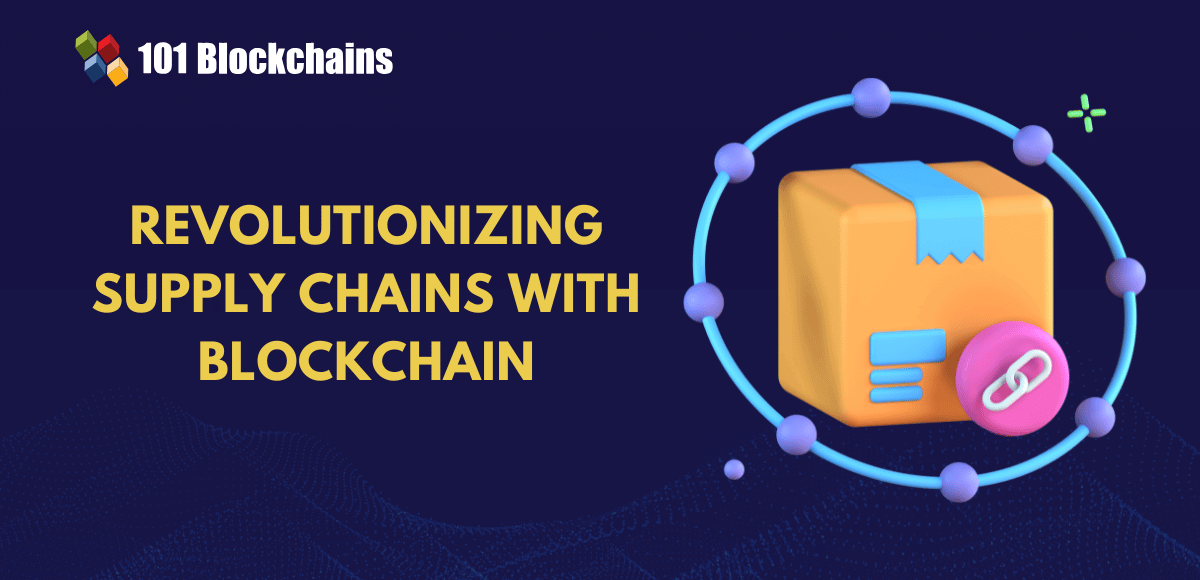Learn how blockchain truly works, master key definitions, and uncover what makes smart contracts so "smart." Dive into the fundamentals, gain valuable insights, and start your blockchain journey today!

- Blockchain
Georgia Weston
- on October 14, 2022
What are Blockchain Bridges and How Do They Work?
Blockchain technology has covered quite an extensive journey since its introduction to the world in 2008 with the Bitcoin whitepaper. The subsequent rise in the number of cryptocurrencies and development of blockchain networks with programmability, such as Ethereum, have created a completely new ecosystem. Blockchain promises the value of decentralization and freedom from the control of any individual or institution. However, majority of blockchain networks exist in the form of isolated communities with their own economies. Therefore, blockchain bridges have become one of the inevitable necessities for the decentralized application ecosystem.
The restriction on interactions between different blockchain networks creates limits for decentralization, the core principle of blockchain technology. A blockchain bridge serves as the ideal solution for interoperability among different types of blockchain networks. It opens up the scope for applications based on one blockchain network to use the resources of another blockchain network.
The maturity and evolution of blockchain technology have led to the demand for blockchain bridge projects to improve interoperability among different blockchain networks. The following discussion offers a detailed introduction to a blockchain bridge and its working alongside the value advantages it presents for the blockchain community. In addition, you can also learn about the risks of a blockchain bridge and examples of projects.
Build your identity as a certified blockchain expert with 101 Blockchains’ Blockchain Certifications designed to provide enhanced career prospects.
What is a Blockchain Bridge?
One of the first things you need to do before you start looking for best blockchain bridges would be to find the definition of one. Investors are gradually showcasing more interest in the field of DeFi. Therefore, the uses of a blockchain bridge are gradually gaining momentum in the decentralized applications ecosystem.
Just like physical bridges, the blockchain bridge connects two separate blockchain networks or applications. A blockchain bridge can work in different ways and has also been referred to as a ‘cross-chain bridge.’ It can facilitate the uninterrupted transfer of assets and information between layer 1 and layer 2 networks as well as between different blockchain networks.
Every blockchain project features specific defining parameters unique to the project, which create problems with interoperability. A blockchain bridge serves as the proven answer to this problem as they can serve as trustless, trusted, bidirectional or unidirectional modes for transferring different transactions and data sets through blockchain bridges. The working of a blockchain bridge can involve exchange of decentralized identities, off-chain information and smart contract calls.
Want to learn blockchain technology in detail? Enroll Now in Certified Enterprise Blockchain Professional (CEBP) Course
What is the Need for Blockchain Bridges?
The fundamentals of a blockchain bridge must have piqued your interest in how they work and the top successful examples. You can find answers to “how blockchain bridges work” by reflecting back on the basics of blockchain. Blockchain networks include a global community of nodes interacting with other in a shred environment for management, validation and storage of financial transactions and data exchanges. The distinct traits of the blockchain networks separate them from one another and create distinct communities. For example, each blockchain network features a consensus model, which is an integral component for ensuring that all nodes can agree on specific transactions.
The conventional consensus mechanism or Proof of Work serves better security, although with additional expenses on energy consumption. Therefore, new blockchain networks have been evolving with the help of innovative consensus models, such as Proof of Stake. The growth of new blockchain networks focused on ensuring combined benefits of decentralization, scalability and security. Therefore, you can notice the massive walls between different blockchain networks and ecosystems, which establish the urgency for blockchain bridges to dictate the future of the blockchain landscape.
Blockchain networks deploy different fragments of code to help developers in deploying applications, tokens and smart contracts over a network. In addition, all blockchain networks feature their own token standard and framework, offering opportunities for development. The expansion of blockchain projects, such as in the DeFi landscape, creates the necessity for bridges. As the number of projects in DeFi would continue increasing in the future, users will need interoperability of assets among different networks. Interestingly, a blockchain bridge offers the foundation for advancing interoperability within the dApps and crypto ecosystems.
Enroll now in the Blockchain Scalability and Interoperability Mastery Course to learn the skills needed to develop faster, scalable, robust, and interoperable dApps.
Variants of Blockchain Bridges
The definition of a blockchain bridge and the underlying rationale showcases a detailed impression of their importance. At the same time, you must have some doubts about the types of blockchain bridges and their work. Interestingly, an overview of the different variants of a blockchain bridge could shed further light on their work. How do you differentiate a blockchain bridge? Just like blockchain networks featuring distinctive defining parameters, blockchain bridges also have different traits.
A specific blockchain bridge could not support and work with every blockchain network or asset in the decentralized applications industry. In addition, you can find a list of blockchain bridges focused on addressing unique user requirements. Here is an outline of the notable blockchain bridge variants you can use for transferring assets and information between blockchain networks.

Please include attribution to 101blockchains.com with this graphic. <a href='https://101blockchains.com/blockchain-infographics/'> <img src='https://101blockchains.com/wp-content/uploads/2022/10/Blockchain-Bridges-Variants.png' alt='blockchain bridge variants='0' /> </a>
-
Trusted Bridges
The first entry among the types of a blockchain bridge would refer to a trusted blockchain bridge. It is basically a protocol governed under a centralized approach, operator, or entity. Trusted blockchain bridge has earned the name as users have to trust the reputation or identity of a centralized bridge and deposit their funds on the bridge. Some of the examples of trusted blockchain bridges have shown proof of user-friendly interfaces, which can help in encouraging more users.
-
Trustless Bridges
The second variant among bridges for blockchain networks would refer to a trustless blockchain bridge. As compared to a trusted blockchain bridge, the trustless variant leverages algorithms and smart contracts over a blockchain network. Therefore, a trustless blockchain bridge does not need any central intermediaries or custodians.
Users don’t have to trust any central authority with the responsibility for their assets. Furthermore, a trustless bridge offers complete transparency by leveraging the advantages of mathematics, computer science and cryptography for security of transactions. On top of it, users have complete control over their assets at different times.
-
Unidirectional Bridges
The next entry among types of blockchain bridges would point at unidirectional bridges. Unidirectional bridges take the direction of transactions into account. As the name implies, unidirectional bridges can only ensure irreversible asset transfers from one network to another. Such types of bridges are only suitable for one-way transactions.
-
Bidirectional Bridges
Bidirectional bridges are another example of a blockchain bridge variant, working exactly opposite to the functioning of unidirectional bridges. A bidirectional blockchain bridge helps in ensuring seamless transfer of assets and information between two networks. Therefore, bidirectional bridges serve as a favorable alternative to using two different unidirectional bridges.
Start learning Blockchain with World’s first Blockchain Skill Paths with quality resources tailored by industry experts Now!
Scope for a Blockchain Bridge
The special highlights and variants of blockchain bridges establish a credible impression of how they are important for the future of blockchain. Bridges offer a promising tool for hopping between different blockchain networks seamlessly. The advantages of a blockchain bridge can offer benefits to developers and investors alongside the blockchain networks connected by the bridge. Blockchain bridges can offer better opportunities for increasing the number of users and more opportunities for development and transfer of assets.
Users can interact with other blockchain networks and their associated applications. For instance, Bitcoin owners could also interact with applications in the Ethereum ecosystem. Furthermore, users can also rely on bridges to extract the best value from applications on various blockchain networks. The use of best blockchain bridges enables better usability of assets from main blockchain networks on layer 2 networks. Since layer 2 solutions offer cost-effective and faster transactions, blockchain bridges can also offer conclusive benefits for scalability while reducing transaction fees.
Developers can also rely on the basics of how blockchain bridges work to achieve promising value benefits. The functionalities of a blockchain bridge integrated into dApps could help in achieving the utilities and benefits of different blockchain networks. With the help of interoperability, scalability and utility, bridges can encourage developers to come up with innovative designs for decentralized applications.
Excited to learn the basic and advanced concepts of ethereum technology? Enroll Now in The Complete Ethereum Technology Course
Risks of Blockchain Bridges
A blockchain bridge might seem like the most practical choice for extracting the actual value benefits of the blockchain ecosystem. However, bridges also present certain setbacks, which should be the priority of everyone in the blockchain landscape. Just like the web3 industry, blockchain bridges are still in the early stages of development. On top of it, the community of blockchain developers believes that the best design for a blockchain bridge has not been created yet. In addition, the risks with a blockchain bridge depend on the type and have a different impact on users and the blockchain community.
For example, trusted blockchain bridge presents the concerns of censorship due to centralized control. On top of it, the custodial risks of exposing assets to malicious bridge operators could also affect users. At the same time, a trustless bridge would also present risks in the form of malware or bug risks in the smart contract code. Furthermore, a trustless bridge entrusts the responsibility of assets to the users, thereby implying possibility of a loss of funds due to user error.
Aspiring to Become a Certified Web3 Expert? Enroll in Certified Web3 Professional (CW3P) Certification Course Now!
Popular Blockchain Bridge Examples
The basics of a blockchain bridge explain the potential as well as downsides of the new solution. You can find a few blockchain bridge projects making their way towards popularity. The bridges provide seamless transactions between popular blockchain networks. In addition, every bridge has a different approach to operations based on its time. Therefore, you are more likely to identify profound variations in the transfer times for every bridge. Here are some of the popular examples that you should take note of.
-
Binance Bridge
The blockchain bridge by Binance serves as a bidirectional bridge between Ethereum and the main Binance chain. It also utilizes specific features of the Ethereum-compatible BNB Smart Chain for wrapping token assets. Therefore, it can help in transferring assets to Ethereum from Binance. The Binance Bridge helps users utilize Ethereum-based assets on the BNB Smart Chain by wrapping tokens in the BEP-20 token standard.
-
Avalanche Bridge
The next popular entry among examples of blockchain bridges would be Avalanche Bridge. It is also a bidirectional bridge for transferring assets between Ethereum and Avalanche networks. Furthermore, the Avalanche Bridge also supports ERC-721 and ERC-20 functionality, thereby supporting the transfer of NFTs and cryptocurrencies. The Avalanche team introduced an update for the bridge in June 2022 and included support for transferring assets between Bitcoin blockchain and Avalanche network.
Start learning Blockchain with World’s first Blockchain Career Paths with quality resources tailored by industry experts Now!
Bottom Line
The outline of blockchain bridge basics, their working, types and advantages show their potential for ruling the future of blockchain. The blockchain community can leverage the bridges for benefits of interoperability and scalability, alongside offering true decentralization. With the growth of blockchain bridge projects, the web3 ecosystem could become stronger and more immersive for users.
Seamless transfer of assets to and fro different blockchain networks can also help developers overcome conventional barriers in dApps development. As the popularity of blockchain applications such as DeFi apps, NFTs and DAOs continue to grow; bridges can offer seamless user experiences. Dive deeper into the domain of web3 and find out the significance of a blockchain bridge for the future now.
*Disclaimer: The article should not be taken as, and is not intended to provide any investment advice. Claims made in this article do not constitute investment advice and should not be taken as such. 101 Blockchains shall not be responsible for any loss sustained by any person who relies on this article. Do your own research!





